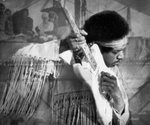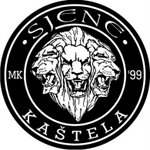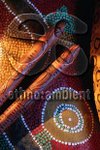
There are few lonelier sounds than a Neil Young solo performance. Most pictures from his solitary jaunts show him surrounded by an army of guitars or hunched over a piano, trapped in the middle of a stark spotlight. Singing in a hushed and fragile voice, it almost sounds like he's locked in a bedroom rather than on a theater stage, and as such it's jarring to hear the rapt-silent crowd explode into applause between songs. Even the material speaks to solitude, as Young dusts off the corner of his songbook concerned with aging and the search for companionship, topics better suited for early-morning insomniac worry, not public performance.
Live at Massey Hall, the second live release in Neil Young's long-awaited and now briskly-paced Archives series, shows that this aspect of Young's persona had already matured in 1971, when the singer was only 26. Coming on the heels of last year's Live at Fillmore East, a disc of barnstorming distortion-pedal epics with his preferred partners Crazy Horse, this birthplace performance is representative of the abrupt downshifts that have marked Young's career. In the two years prior, he had released his loudest record to date, Everybody Knows This Is Nowhere, and participated in mega-ultra-supergroup Crosby, Stills, Nash, and Young, so of course the next step according to Neil Logic was to put the amps in storage and road-test an acoustic one-man show.
The January 1971 tour fell between Young's After the Gold Rush album, where his folk origins had started to seep back in amidst the overdrive of songs like "Southern Man", and 1972's Harvest, the warm country-rock crossover that won him his greatest commercial success. Many of the Harvest songs show up in this set still dripping from their compositional birth, and, stripped of their eventual Nashville pageantry, they're surprisingly morose. Without its plucky banjo and Linda Ronstadt/James Taylor backing vocals, "Old Man" shows itself to be more about the horror of growing old alone than country comfort, and the eventual mega-hit "Heart of Gold" is tossed off as the bridge to a stripped-bare version of "A Man Needs a Maid", one of Young's most painfully misanthropic songs.
Other new songs are no less glum, but make a case for Young as an underappreciated piano player. "Love in Mind", a minor-key lament from the criminally out-of-print Time Fades Away, is a hangover valentine that's teasingly short, while "See the Sky About to Rain", stripped down from its Rhodes-heavy On the Beach version, reveals itself as a neglected gem, featuring surprisingly complex key-tickling. Two songs that never made it to record show up as well, the mournful country tune "Bad Fog of Loneliness" (see what I mean?) and the silly throwaway "Dance, Dance, Dance", which appears to serve largely as a cheer-up send-off for Young's Toronto audience.
One of the strengths of Young's acoustic sets is that they carry a distinct identity from his electric work; they're not merely "unplugged" versions of his high-volume catalog, but a completely different mood designed to emphasize his wounded nasal voice and delicate finger-picking. Even so, the highlights of this particular set come from reinterpretations of electric hits, such as the reprises of Fillmore East showstoppers "Cowgirl in the Sand" and "Down By the River" recast as chilling murder ballads. The most effective makeover is given to the sometimes-maligned "Ohio", which in solo form (without the histrionics of CSNY's version) is less an angry screed than a perfect and still-relevant encapsulation of political helplessness, all half-finished thoughts and pervasive sadness.
All this gloom and doom was only going to build for Neil Young over the years following this tour; his new "The Needle and the Damage Done" foreshadowed the ensuing half-decade of addiction and death that would inspire some of his finest records. Live at Massey Hall catches Young divining that bleak future from the darkness of the crowd, caught alone at the microphone, a chilling example of why he was, in this particular guise, the 70s' best architect of lonesomeness.
-Rob Mitchum March 13, 2007
Live at Massey Hall, the second live release in Neil Young's long-awaited and now briskly-paced Archives series, shows that this aspect of Young's persona had already matured in 1971, when the singer was only 26. Coming on the heels of last year's Live at Fillmore East, a disc of barnstorming distortion-pedal epics with his preferred partners Crazy Horse, this birthplace performance is representative of the abrupt downshifts that have marked Young's career. In the two years prior, he had released his loudest record to date, Everybody Knows This Is Nowhere, and participated in mega-ultra-supergroup Crosby, Stills, Nash, and Young, so of course the next step according to Neil Logic was to put the amps in storage and road-test an acoustic one-man show.
The January 1971 tour fell between Young's After the Gold Rush album, where his folk origins had started to seep back in amidst the overdrive of songs like "Southern Man", and 1972's Harvest, the warm country-rock crossover that won him his greatest commercial success. Many of the Harvest songs show up in this set still dripping from their compositional birth, and, stripped of their eventual Nashville pageantry, they're surprisingly morose. Without its plucky banjo and Linda Ronstadt/James Taylor backing vocals, "Old Man" shows itself to be more about the horror of growing old alone than country comfort, and the eventual mega-hit "Heart of Gold" is tossed off as the bridge to a stripped-bare version of "A Man Needs a Maid", one of Young's most painfully misanthropic songs.
Other new songs are no less glum, but make a case for Young as an underappreciated piano player. "Love in Mind", a minor-key lament from the criminally out-of-print Time Fades Away, is a hangover valentine that's teasingly short, while "See the Sky About to Rain", stripped down from its Rhodes-heavy On the Beach version, reveals itself as a neglected gem, featuring surprisingly complex key-tickling. Two songs that never made it to record show up as well, the mournful country tune "Bad Fog of Loneliness" (see what I mean?) and the silly throwaway "Dance, Dance, Dance", which appears to serve largely as a cheer-up send-off for Young's Toronto audience.
One of the strengths of Young's acoustic sets is that they carry a distinct identity from his electric work; they're not merely "unplugged" versions of his high-volume catalog, but a completely different mood designed to emphasize his wounded nasal voice and delicate finger-picking. Even so, the highlights of this particular set come from reinterpretations of electric hits, such as the reprises of Fillmore East showstoppers "Cowgirl in the Sand" and "Down By the River" recast as chilling murder ballads. The most effective makeover is given to the sometimes-maligned "Ohio", which in solo form (without the histrionics of CSNY's version) is less an angry screed than a perfect and still-relevant encapsulation of political helplessness, all half-finished thoughts and pervasive sadness.
All this gloom and doom was only going to build for Neil Young over the years following this tour; his new "The Needle and the Damage Done" foreshadowed the ensuing half-decade of addiction and death that would inspire some of his finest records. Live at Massey Hall catches Young divining that bleak future from the darkness of the crowd, caught alone at the microphone, a chilling example of why he was, in this particular guise, the 70s' best architect of lonesomeness.
-Rob Mitchum March 13, 2007
full artwork included
LINK: ("!!" = "tt")









4 comments:
I like that album very much. It's do different in comparison with the concert at the Fillmore with The Crazy Horse.
Neil Young is a great musician!
I fully agree with you Georgi. This is one of if not the best Neil Young`s solo performance. :)
i realize you are really busy posting new stuff but, if you get a chance, could you repost this album? all of your work is appreciated nevertheless
O.K. Tmrw!!!
rockanthology
Post a Comment